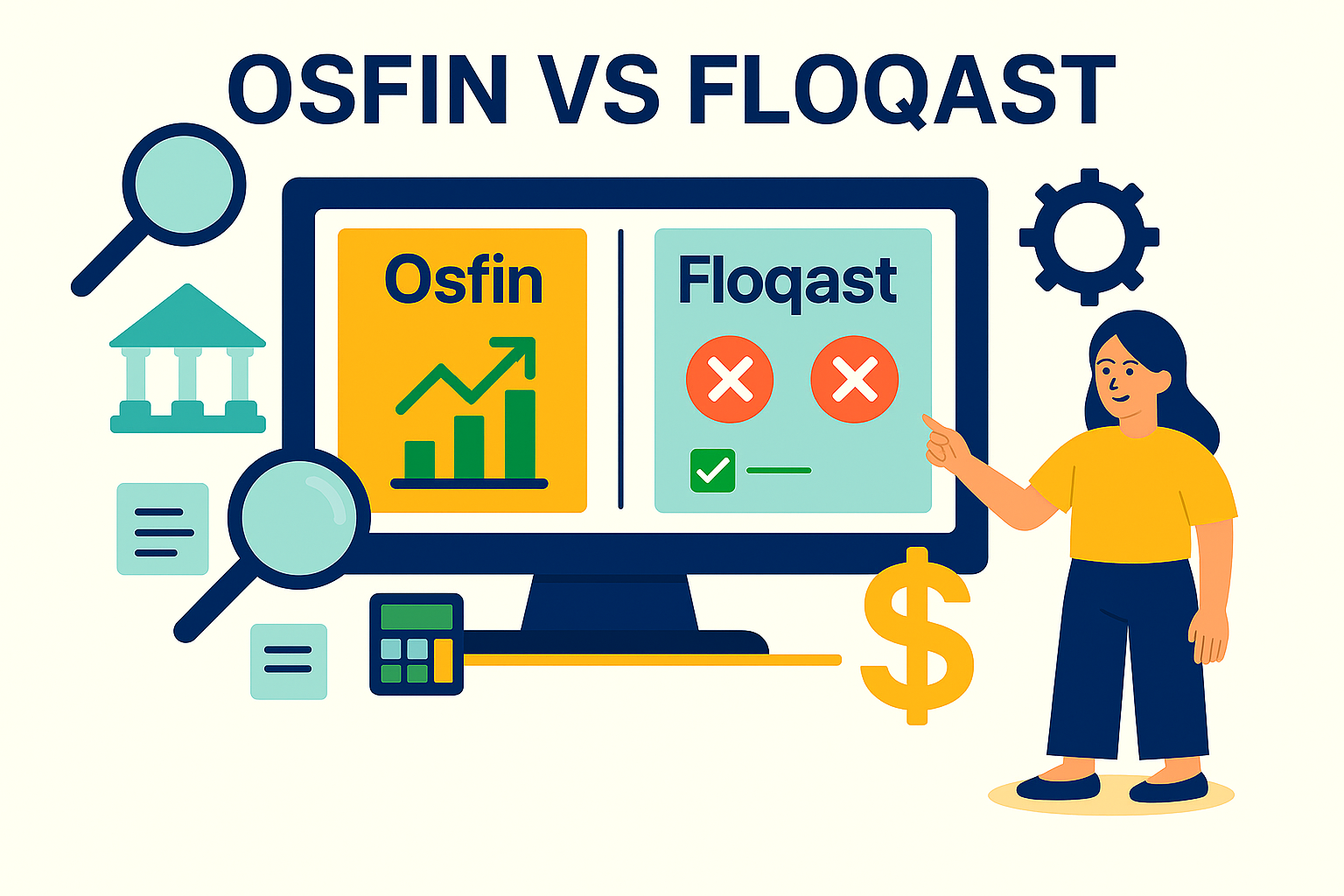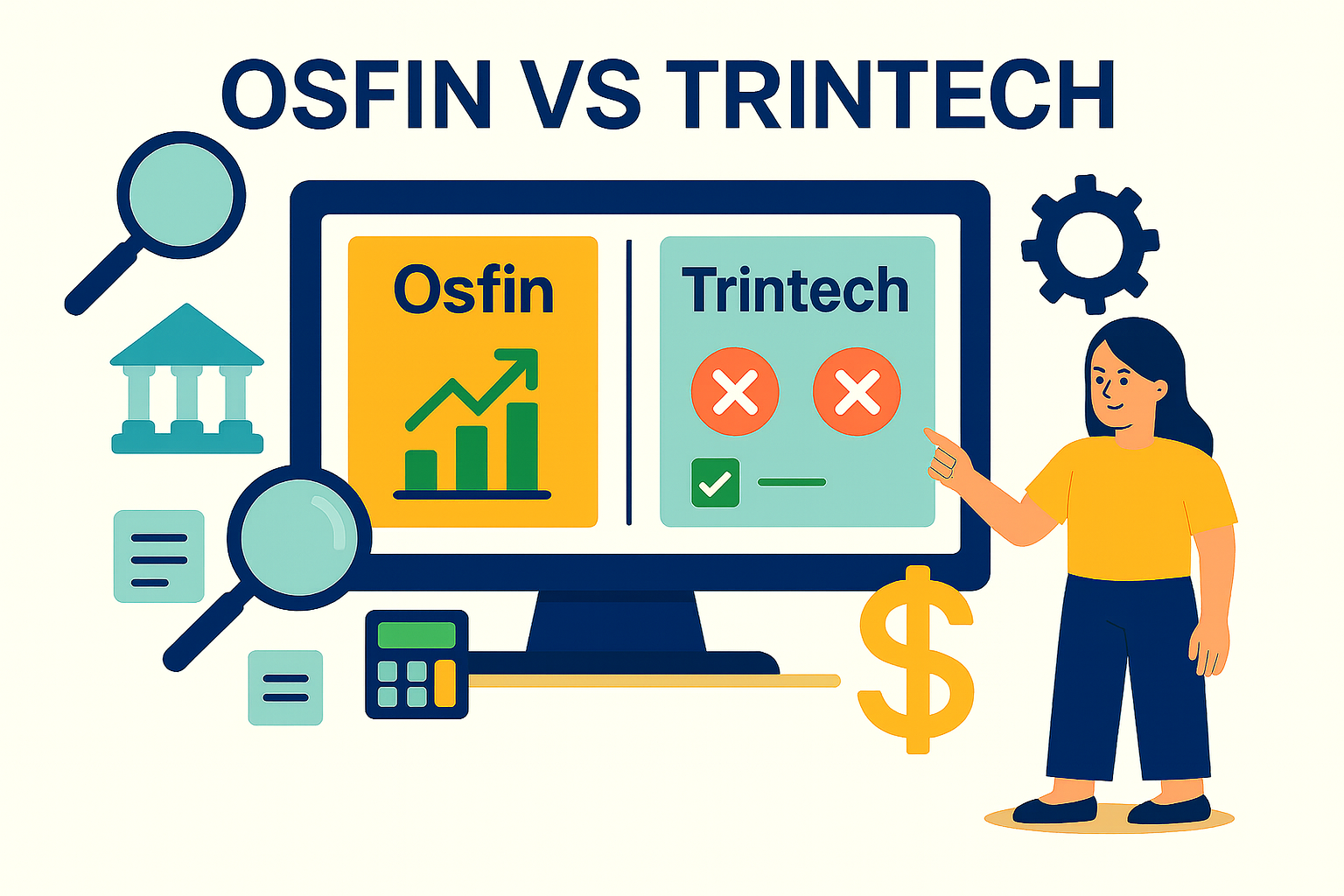Brokerage Reconciliation Explained: Ensuring Accuracy in Trades and Transactions
In 2025, trade volumes have risen across capital markets. As stated by Tradeweb, an average mid‑size institution processes over $2.71 trillion in average daily volume. With each transaction, a broker confirms the details such as, quantity, price, and timestamp.
Finance and operations teams cannot afford mismatches, however, many are still dependent on spreadsheets, or manual cross-checks to reconcile broker data. A 2024 study by the Journal of Accountancy stated about 40% of the CFOs find it hard to fully trust the accuracy of their organisations financial data. This problem is faced across brokers, geographies, and asset classes.
This article explains why brokerage reconciliation is a core control function, along with what it involves, how it differs from trade reconciliation, what causes data mismatches, and where most processes fail.
What this blog covers:
- What brokerage reconciliation is and why it matters
- How it differs from trade reconciliation
- Common causes of mismatches (prices, timestamps, fees, data errors)
- Risks and consequences of faulty reconciliation
- Best practices to streamline and automate brokerage reconciliation
- How Osfin’s platform supports reconciliation across brokers/custodians
- Real-world examples and lessons learned
- Frequently asked questions around Brokerage Reconciliation
What is Brokerage Reconciliation?
Brokerage reconciliation makes sure your internal records match with the trades, positions, and balances reported by your broker or custodian. Every transaction is checked for accuracy using metrics such as, prices, ISINs, and timestamps.
When this process breaks, the immediate impact includes delayed settlements, and failed audit trails and P&L reports. A single mismatch can cause serious reporting issues across departments, especially where teams are handling thousands of trades every day.
This depicts the importance of reconciliation which is a core financial control that affects compliance, reporting, and operational stability for any organization. Understanding this process can provide accuracy, speed, and real control over your data, which will also allow you to scale sustainably. In the next section, we’ll look at why brokerage reconciliation is necessary for your financial management.
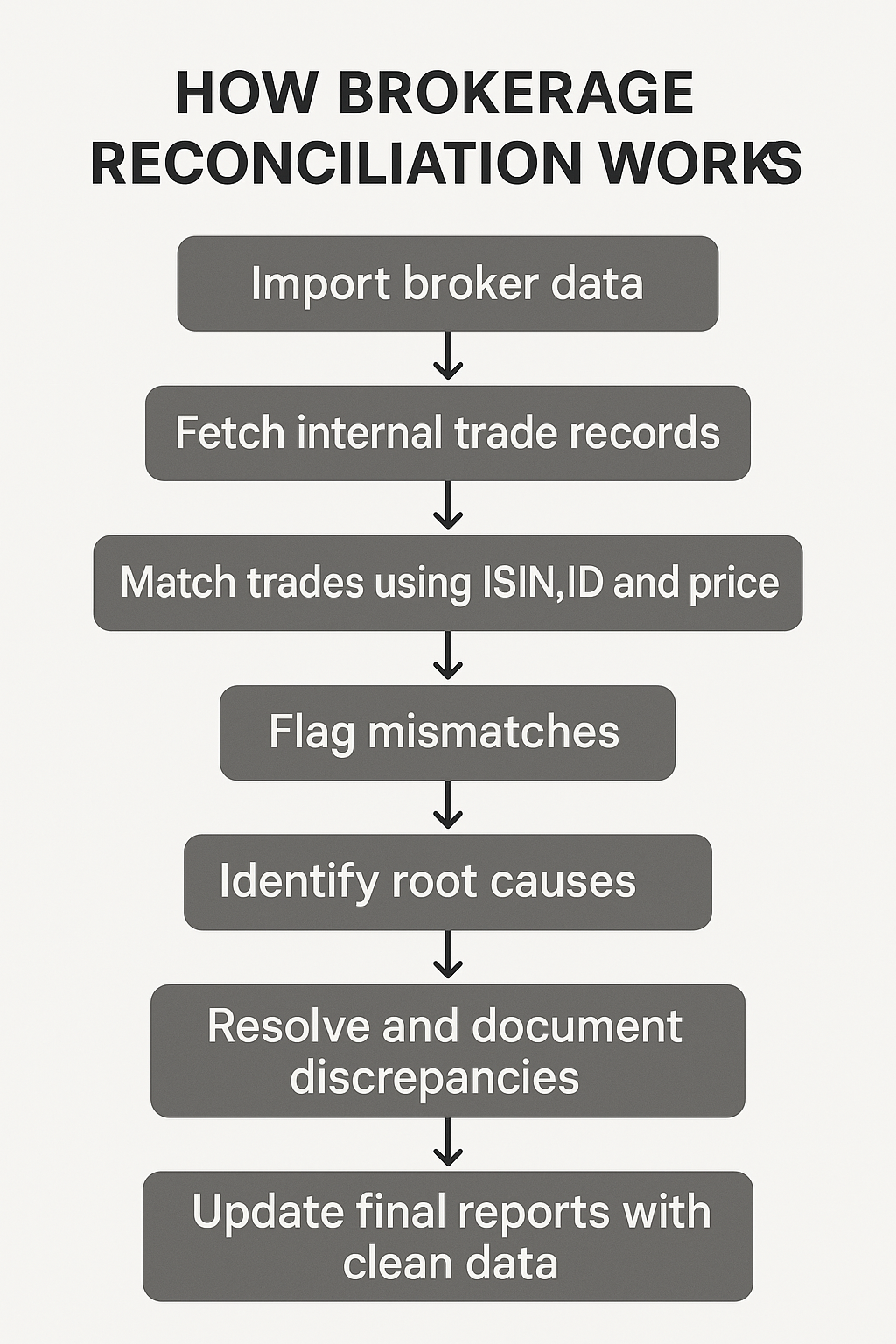
Importance of Brokerage Reconciliation in Financial Management
Brokerage reconciliation improves data accuracy, timely reporting, and prevents errors in financial systems. The points below will help you understand its significance.
1. Keeps every trade accurate
Financial data mismatches between internal systems and broker records lead to anomalies like mispriced trades, incorrect ISINs, and duplicate entries. Reconciliation flags such discrepancies early, thus, stopping errors from escalating further.
2. Prevents settlement delays
Unreconciled trades delay settlement cycles. A consistent reconciliation process verifies the trade data before settlement deadlines.
3. Backs your audit trail
Auditors and regulators expect every transaction to be traceable. Reconciliation marks the matching of trades, error management, and actions taken to reduce friction during audits.
4. Protects your P&L
A single trade with an incorrect price can change and falsify the reported revenue. Reconciliation makes sure clean and verified trades are reflected in the records, while preserving the accuracy of profit and loss statements.
5. Enables faster decision-making
When leadership needs to act, access to correct trade data and records is a must. Reconciliation keeps everything up to date and accurate. It allows decision-makers to modify strategy without second-guessing the numbers.
6. Enables automation
Broken or mismatched inputs disrupt downstream systems and workflows. Reconciliation helps create a reliable business foundation using stable and verified data only. This allows finance teams to scale operations and set up automation tools without errors.
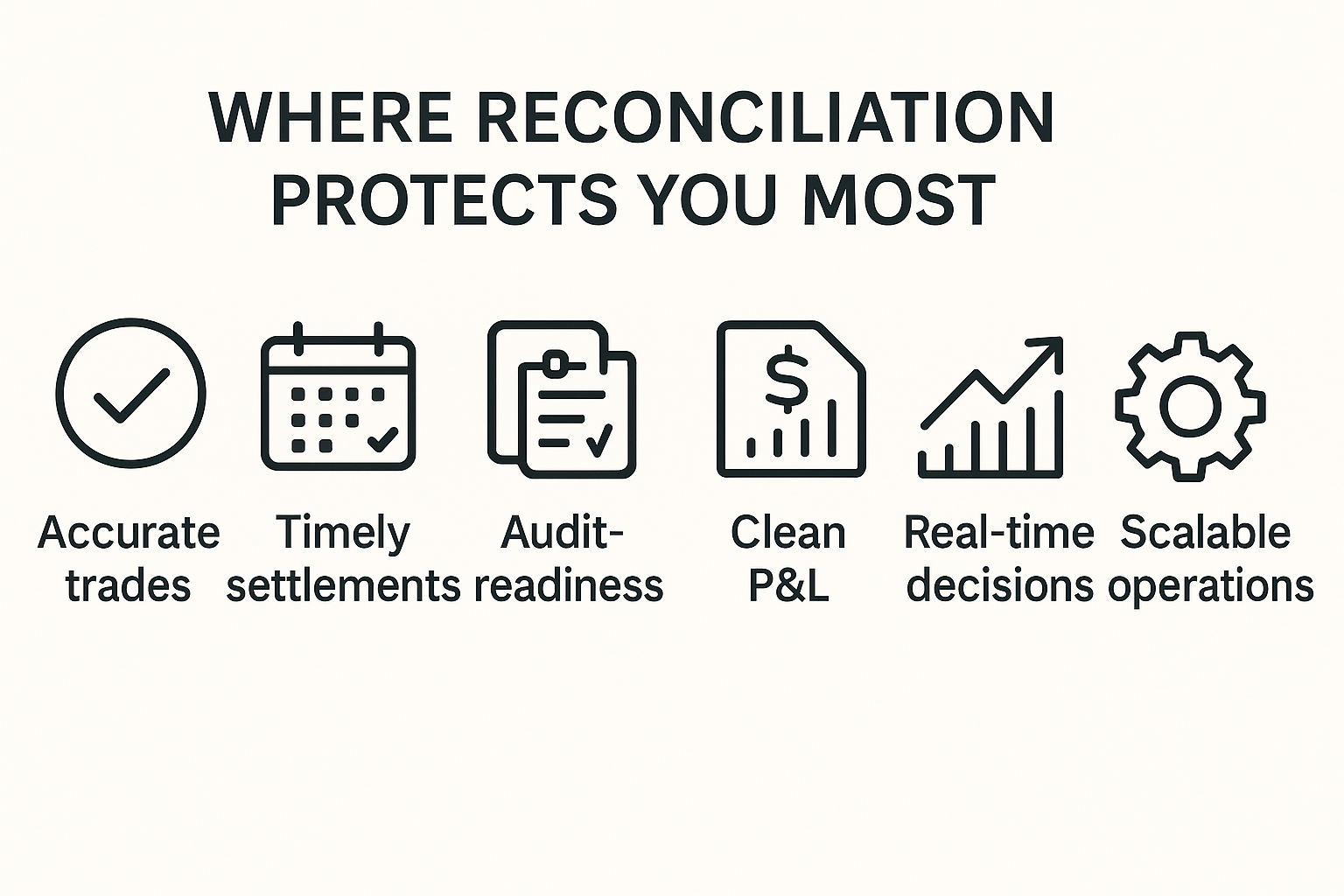
{{banner1}}
Brokerage Reconciliation vs Trade Reconciliation: What’s the Difference?
These two processes are closely related but serve different purposes:
While trade reconciliation checks the consistency of your own systems, brokerage reconciliation confirms that your numbers match the external world. Both are critical as one proves internal and operational accuracy whereas the other checks your data externally.
Next, let’s cover the key components involved in brokerage reconciliation.
Key Components Involved in Brokerage Reconciliation
The brokerage reconciliation process is more than just about comparing numbers. The list below entails everything that goes into brokerage reconciliation to ensure full data alignment.
1. Trade files from brokers or custodians
These files contain executed trade details like price, quantity, timestamp, trade ID, ISIN, and asset class. They act as the external source of truth.
2. Internal transaction records
Internal transaction records are pulled from front-office systems, OMS, or PMS. These include trade bookings, allocations, and timestamps that are tracked internally.
3. Position and balance data
Custodians send position files or cash statements showing settled balances. These must match internal records at end-of-day.
4. Fee and commission records
Fee and commission records include brokerage fees, transaction charges, and clearing costs. Matching them with expected values helps you spot any overcharges or missed information.
5. Reconciliation engine with exception logic
This is the core system which can be manual, semi-automated, or fully automated. It pulls data from both internal trade systems and external broker sources to compare every entry across systems. Built-in rules flag issues like missed trades, pricing errors, or incorrect timestamps.
But how do these components work together in the reconciliation process? We’ll cover this next.
The Brokerage Reconciliation Process: Step-by-Step
Reconciliation means to regularly pull data, detect mismatches, to resolve them before they begin affecting downstream financial processes. Here's how the process flows:
1. Import broker and custodian files
At the start of each reconciliation cycle, trade, position, and balance reports are fetched from brokers, custodians, or clearing platforms. These can be obtained via secure feeds, SFTP, or APIs, and are to be compared against your internal data sources.
2. Pull internal trade data
Internal trade data, such as logs. Positions and settlement details, comes from your front-office and back-office systems. The values of the above mentioned data should always stay the same as that in your broker reports.
3. Match line items by ISIN, price, and trade ID
Each record is scanned across systems and matched on identifiers like ISIN, trade ID, price, and timestamp. It is always advisable to spot mismatches at this stage to avoid downstream issues.
4. Log breaks across trades, positions, or timestamps
Avoid missing trades, quantity mismatches, incorrect pricing, or inaccurate timestamps in a system where every mismatch is counted as an exception. These exceptions are then added into queues for review.
5. Investigate what caused the break
Each exception is traced back to its root whether it is a delayed broker feed, an internal booking error, or a timing misalignment. Tracing the root cause helps in locating where the break occurred, so you can prepare to avoid it if it happens again.
6. Resolve the mismatch and document the fix
Once the mismatch is diagnosed, it is resolved either on the internal end or with the broker. It’s important to log every action to keep audit trails clear so that regulators can easily trace each correction.
7. Route clean data into downstream systems
When the reconciliation process is completed, the clean and verified data is entered into downstream systems like dashboards and compliance reports. This data that gets processed further should always be final and free of mistakes.
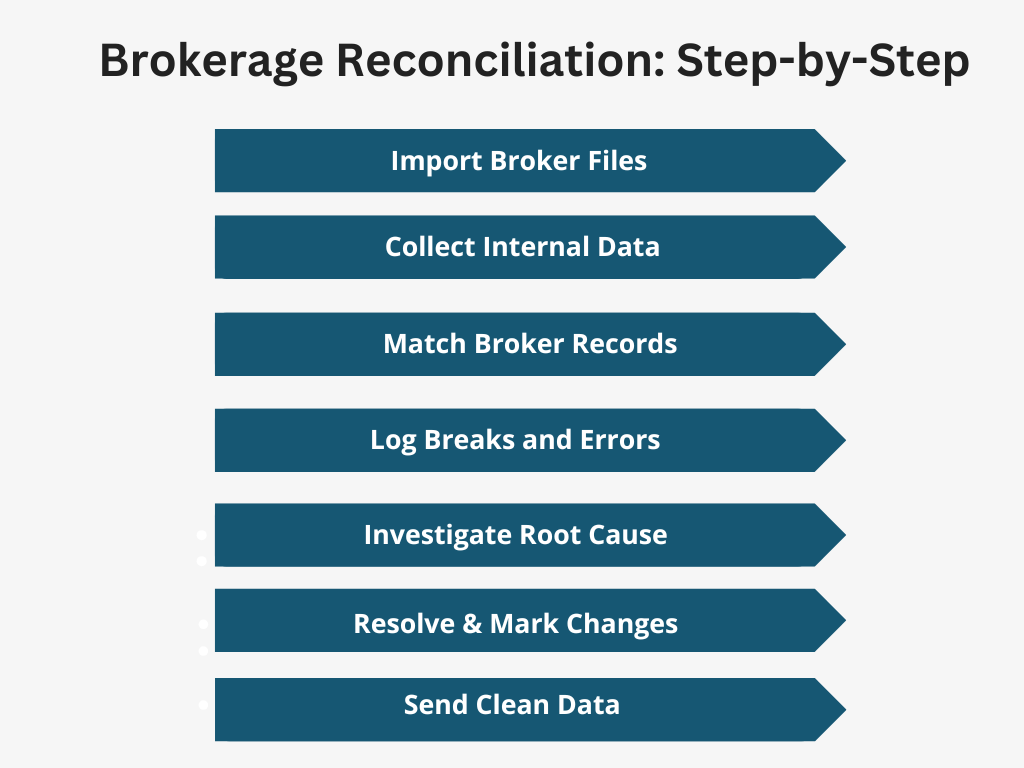
Common Challenges in Brokerage Reconciliation
Reconciliation sounds simple but when carried out at scale, the process involves some roadblocks. Here’s what most teams get stuck with:
- Late or incomplete arrival of broker or custodian files can affect and delay the reconciliation timeline.
- File formats sometimes differ depending on sources which forces operations teams to manually correct and align all data.
- It is possible for a single trade record to appear twice or get split into multiple entries, This messes up the transaction totals and can even go unnoticed.
- Using manual reconciliation tools like spreadsheets and semi-automated workflows can increase workload on your financial teams, and hide blind spots when data volumes spike.
- If operations and finance teams lack clear handoff procedures it can lead to unresolved and unreconciled data for long periods of time.
Thus, automation becomes a major necessity when these problems start mounting up. The next section will explain how automation has become the new standard for fast and accurate reconciliation that helps you scale.
{{banner2}}
Why Automating Brokerage Reconciliation is Critical
Manual reconciliation works in the beginning. But as trade volumes grow, it quickly starts to fall apart.
Automation fixes that when broker data flows directly into the system, matching rules run in real time, and mismatches are flagged the moment they occur. It also changes how exceptions are handled, as automated systems apply rules and thresholds. They focus attention on issues like missed trades or incorrect pricing.
Each action is tracked and time-stamped, which keeps your records audit and compliance ready.
With the right automated reconciliation tool, reconciliation is infinitely simplified.
Osfin’s Role in Brokerage Reconciliation Automation
Osfin replaces the manual labour of brokerage reconciliation with a unified, fully automated system. Its key features span the following:
Smart Transaction Matching & Reconciliation
- AI-driven logic for partial, multi-source, and transaction-level matching across ledgers, bank statements, ERPs, and clearing files
- Auto-reconciliation of payment gateway reports, including fees, taxes, and settlements
- Duplicate detection, outlier spotting, and real-time exception tagging with smart team routing
Flexible Data Integration & Format Support
- Supports all major file formats including MT940, ISO 20022, CSV, JSON, and XML
- 170+ pre-built connectors to ERPs, core banking systems, processors, and APIs
Customizable & User-Friendly Workflows
- No-code rule builder for custom tolerances and workflows
- Live dashboards to monitor exceptions, exposure, and match status
Security, Compliance & Auditability
- End-to-end encryption, role-based access control, and two-factor authentication
- Audit-ready workflows with full transaction traceability
- Compliance-ready: SOC 2, PCI DSS, ISO 27001, GDPR
Deployment & Expert Support
- Fast deployment with minimal IT effort
- Ongoing support from domain experts in reconciliation and finance operations
As a result, your teams get clean, real-time data, and effective audit trails. Moreover, it works at scale, adapting as your data volume grows. Osfin reconciles up to 30 million records in under 15 minutes, with 100% accuracy, easing brokerage reconciliation and automation for your organization.
Osfin.ai makes sure your brokerage reconciliation process works, fully automated and fully under control.
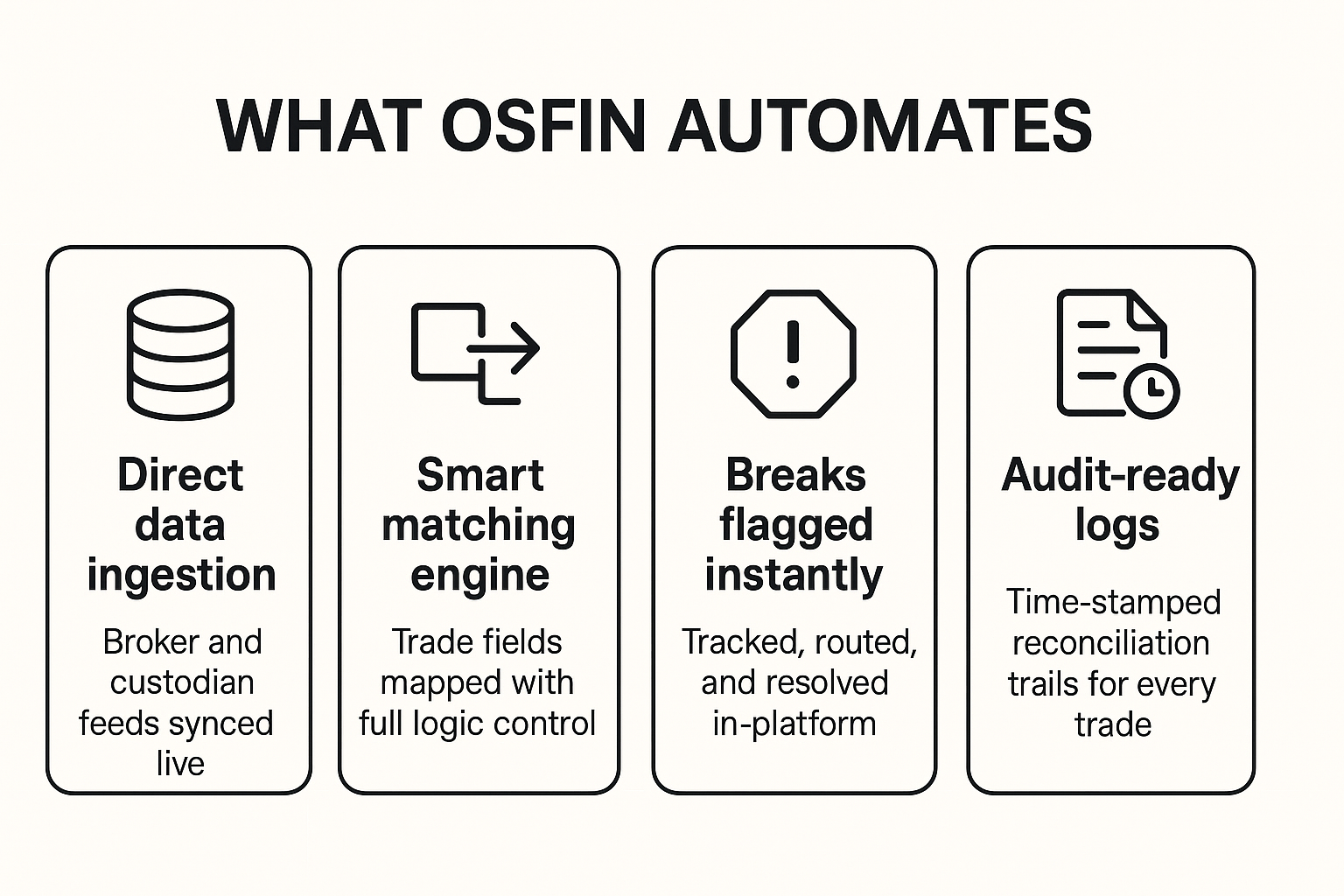
{{banner3}}
FAQs on Brokerage Reconciliation
1. Why does brokerage reconciliation break as volumes scale?
Brokerage reconciliation can break because brokers use different file formats, naming conventions, and delivery schedules. Small mismatches can compound, and manual tools can’t keep up. For scaling volumes of financial data, automated reconciliation is the right step forward.
2. Is it enough to reconcile just at the end of the month?
Monthly reconciliation creates blind spots that slow teams down. Breaks are harder to trace as the time passes. Daily or weekly reconciliation keeps the process tight and audit-ready while transactions are still fresh. With tools like Osfin, this process is automated and sped up.
3. What makes broker files hard to reconcile?
Broker files vary in format, naming, and timestamps. Without a system to normalize these inconsistencies, reconciliation becomes messy and slow, delaying reviews and risking missed breaks. An automation tool like Osfin.ai takes care of the variabilities.
4. What happens when a trade is missing from the broker’s file?
If reconciliation is manual, a missing trade might get caught late or be missed entirely. With an automated reconciliation workflow, the system flags it instantly so your teams can escalate, confirm, or correct it before it creates downstream errors.
